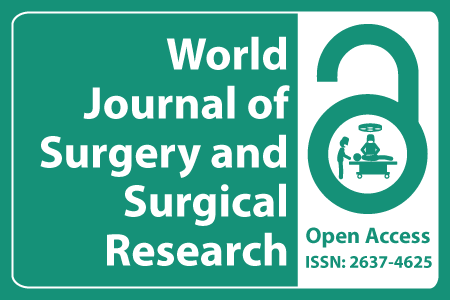
Journal Basic Info
- Impact Factor: 1.989**
- H-Index: 6
- ISSN: 2637-4625
- DOI: 10.25107/2637-4625
Major Scope
- Surgical Oncology
- Podiatric Surgery
- Cardiothoracic Surgery
- Obstetrics & Gynecology
- Otolaryngology & ENT Surgery
- Hand Surgery
- Breast Surgery
- Gynecological Surgery
Abstract
Citation: World J Surg Surg Res. 2019;2(1):1101.DOI: 10.25107/2637-4625.1101
Perforator Vessels of the Upper Chest: New Evidence from an Anatomic Study
Vakis Georgios, Markopoulos Christos, Karypidis Dimitrios, Bakopoulos Anargyros, Spiliopoulou Chara and Papadopoulos Othon
Department of Plastic Surgery, National and Kapodistrian University of Athens, Greece
Department of Anatomy and Surgical Anatomy, National and Kapodistrian University of Athens, Greece
Department of Forensic Medicine and Toxicology, National and Kapodistrian University of Athens, Greece
Department of Surgery, Attikon University Hospital, National and Kapodistrian University of Athens, Greece
*Correspondance to: Vakis Georgios
PDF Full Text Research Article | Open Access
Abstract:
Introduction: Vascularized tissue transfers based on perforator vessels have been proven to be reliable and versatile reconstructive procedures. In upper chest, such surgical procedures provide efficient post tumor extirpation or trauma defect reconstruction as well as improved aesthetic and quality of life outcomes. In this study the anatomic characteristics of the perforator vessels in the upper half of the breast are presented and analyzed.
Methods: The dissection of 15 female adult fresh-frozen cadavers was performed. Perforators found during the deep subcutaneous/suprafascial dissection were marked, preserved and traced down to their origin at the intra- and submuscular level. All perforator vascular pedicles (arteries and veins) greater than 0.4 mm were preserved and marked. All measurements were taken in millimeters using a micrometer.
Results: The diameter of the dominant internal mammary artery perforator was 0.8 mm to 1.9 mm, and of the accompanying vein, 1.2 mm to 2.8 mm. Average sizes of lateral thoracic artery perforators was 1.40 mm ± 0.25 mm one main thoracoacromial artery perforator was usually identified in most subjects.
Conclusion: The identification of upper chest perforator vessels and the confirmation of their anatomic characteristics through comparative analysis with existing literature have a fundamental comprehensive role leading to efficient surgical planning.
Keywords:
Perforator vessels; Autologous breast augmentation; Breast oncoplastic and reconstructive surgery; Microsurgery; Internal mammary perforators; Thoracoacromial artery; Lateral thoracic artery; Perforator pedicles
Cite the Article:
Georgios V, Christos M, Dimitrios K, Anargyros B, Chara S, Othon P. Perforator Vessels of the Upper Chest: New Evidence from an Anatomic Study. World J Surg Surgical Res. 2019; 2: 1101.













